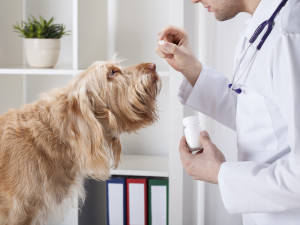A Pain in the Ear: What to Know About Dog Ear Infections
Dogs are especially at risk for ear infections. Here’s what to look out for.

share article

Your pet wants you to read our newsletter. (Then give them a treat.)
If you’ve ever had to fight off an ear infection, you know how painful, itchy, and just icky they can be. As it turns out, when it comes to ear infections, humans are the lucky ones: Our ear canals are short, while dogs’ ear canalsopens in a new tab are long and narrow, making them especially at risk to infection. While diagnosis and treatment should always be handled by a veterinarian, pet parents can help keep their pup’s ears free of infection by learning the signs and symptoms.
What causes ear infections in dogs?
“There are multiple causes of ear infections (otitis externa), including allergiesopens in a new tab (most common), ear mites, a foreign body (this can include polyps or neoplasia), excess hair in the ear canal, anatomic changes in the ear canal, excess moisture in the ear canal, injury, immune-mediated diseases, endocrine disease, and excessive cleaning,” says Dr. Lori Teller, a clinical associate professor at the Texas A&M College of Veterinary Medicine and Biomedical Sciences. “Any of these causes allow for bacteria and/or yeast to overgrow in the ear, leading to the infection.”
What are the symptoms of ear infections?
Signs of ear infections in dogs include head shaking, scratching at or rubbing the affected ear, discharge, bad odor, redness inside the ear, swelling of the ear canal, painopens in a new tab, itchiness, and crusts or scabs inside the ear or along the ear margin. Pet parents who suspect that their dog may be suffering from an ear infection should seek veterinary help immediately; these infections can become more severe if left untreated.
How are ear infections diagnosed?
To diagnose your pet, a veterinarian might sample ear discharge or look through the ear canal to observe the state of the eardrum. Depending on the situation, your dog may need to be sedated for this procedure.
Once diagnosed, your dog’s treatment plan will depend on what caused the ear infection in the first place. Dr. Teller says that topical ointments may be used to treat bacteria and yeast present in the canal. Dogs with severe infections or those involving the middle or inner ear canal may be treated with oral antibiotics and anti-inflammatory drugs. Your vet might also prescribe medicated ear cleansers to clear away discharge and debris from the infected canal.
How can I prevent my dog from getting an infection?
“Dogs that develop ear infections frequently will need to have the underlying cause addressed,” Dr. Teller says. “Some may require therapies to control allergiesopens in a new tab. If a food allergy is a cause of the problem, then switching to a hypoallergenic or limited-ingredient diet may prevent future problems. It is very important to work with your veterinarian before switching your dog’s diet.”
Dogs who swim frequently are also more prone to ear infections, and pet parents should take special care to appropriately clean and dry their pet’s ears after being in the water. Never use cotton swabs in the inner canal of a dog’s ear. Dr. Teller also advises that pet parents should not allow other dogs to lick their pet’s ears.
If you suspect your dog has an ear infection, make an appointment with your vet right away, as early detection can prevent permanent damage from occurring. Proper care will have your pup back to their super-hearing self in no time.

Jennifer Gauntt
Jennifer Gauntt, MA, is the communications director at Texas A&M University College of Veterinary Medicine & Biomedical Sciences, where she covers scientific advancements in pet heath and behavior. This story was originally published by Pet Talk, a service of the College of Veterinary Medicine & Biomedical Sciences, Texas A&M University. Original stories can be viewed on the web at vetmed.tamu.edu/news/pet-talkopens in a new tab. May be edited for style and length.
Related articles
![A happy woman is lying on a bed, her dog smelling her face.]() opens in a new tab
opens in a new tab9 Diseases You Can (and Definitely Can’t) Catch From Your Dog
Here’s what you can scratch off your “Worry About This” list.
![Woman with long straight black hair and a gold nose ring holding a senior Shiba Inu mixed breed dog wearing a red harness]() opens in a new tab
opens in a new tabSenior Wellness Checks for Dogs
Tips to help your oldster live long and prosper.
![Smiling veterinarian examining medical documents of a Bulldog standing on her examination table]() opens in a new tab
opens in a new tab10 Tips to Give Your Dog a Blissful Vet Visit
Reduce the stress of veterinary visits — for you and your pup.
![A vet holding medicine near a dogs face]() opens in a new tab
opens in a new tabHow to Find a Veterinary Specialist
Just like your doctor would refer to you a specialist for expert care for a complicated issue, your vet may do the same for your dog.
![A German Shepherd Puppy sitting on a pink couch with head tilted]() opens in a new tab
opens in a new tabCall Alfred Hitchcock — Can Dogs Get Vertigo?
Learn the signs to look out for this condition.







